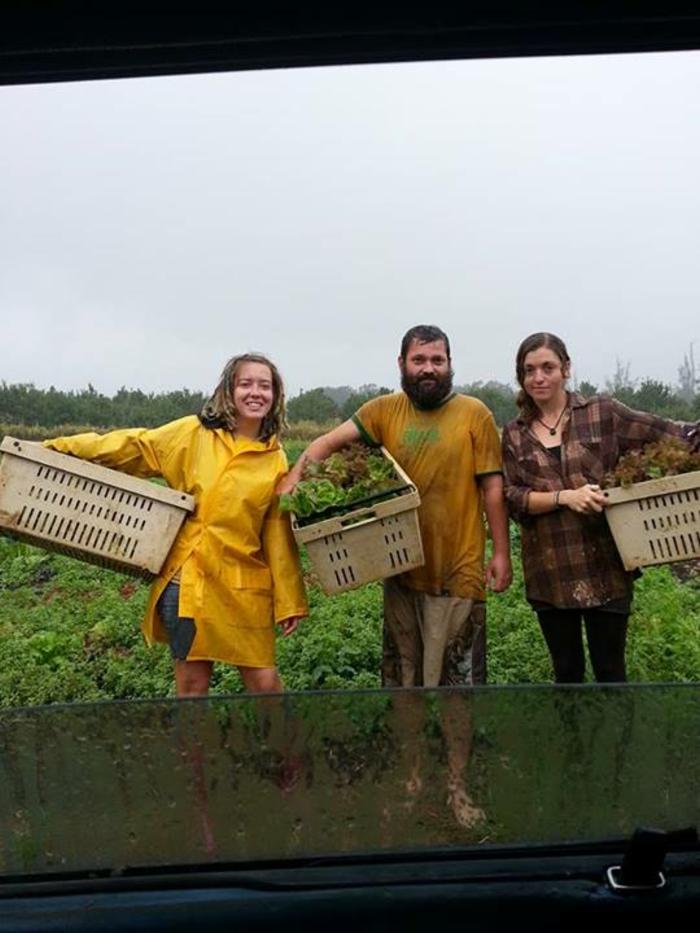Harvesting Tips And Tricks
This kind of harvesting and packing is called “one cut in the field” because your state laws only allow you to cut the vegetable and remove bad leaves before putting it in a box or bag; no cutting of leaves, mixing vegetables, or washing them is allowed without a certified processing facility to do it in.
Laws vary by state, but usually your state Health Department will require you to have a legal “commercial kitchen” to do things like make lettuce mixes, salad mixes, cut broccoli or cauliflower florets; that is, any procedure that involves cutting or washing vegetables is required to be done in a certified commercial kitchen. We’ll cover how to do that legally in a separate post titled “Value-Added Processing For Your Aquaponic Produce”.
(Below) This is lettuce harvesting in standard conditions: down on your knees in the mud (or dirt) in the rain (or sun). The field boss in the truck is nice and dry!
Cut greens and other vegetables with ceramic knives; the cut ends don’t brown as badly as they do when cut with metal knives. Get everything you harvest chilled as soon as possible in an ice water bath; never let it sit in the sun! Our sink setup in our processing shed floats bugs and detritus off the vegetables and down the drain while the vegetables are being rinsed and pre-chilled in ice water at the same time. Our large lettuce spinner was made from a $25 washing machine with a broken wash cycle but a working spin cycle.
Harvest cut-and-come-again and others by lifting entire rafts out of the system, putting them on movable sawhorses at waist level, and cutting/removing produce into baskets at waist level; avoids working bent over. Put cut-and-come-again rafts back into system to regrow for next harvest, other rafts are cleaned and replanted.
HINT TO MAKE HARVESTING EASIER: Build your system so you can harvest from the same end of the troughs all the time; as you harvest, the other rafts float down the system towards you. You put in newly planted rafts at the far end from the harvest end, which is where your sprouting tables should be located so it’s the shortest possible distance from sprouting table to trough.
1. Cut-And-Come-Again
Cut-and-come-again harvesting is used on things such as broccoli and basil. You pick up the raft (don’t break it in the process) and put it on sawhorses to do your chopping (or do it while still in the system if you want a sore back). You then put the raft back in the system, and let it grow for some time until the additional plant mass creates your next harvest. You can do this four or five times with some crops, or forever with others such as watercress and leeks.
Some crops produce more with less work if you just harvest it all out of the system and plant new. Some experimentation on things like basil is necessary to determine whether cut-and-come-again or batch harvesting (when you take the whole plant) produces better yields and less work. This is an area that aquaponics doesn’t have enough definitive data on. Your production will be different for sure, so experiment to see what is most effective and productive in your climate and area.
2. Remove And Sell Whole
This is really simple: take the whole thing out, put it in a box, and sell it to someone. You will get less money for it than if you do something to it and add value. Most State Health Departments allow you to do this, which is called “one cut in the field”, then put the vegetable in a box. Any more processing, i.e. two cuts, washing and drying the vegetable, or making any kind of vegetable mix, requires a State-Health Department Certified Processing Facility (sometimes also referred to as a commercial kitchen) (Also see the section “State Health Department Processing Requirements For Vegetables”).
3. Pick Vegetables/Remove Unwanted Growth
Produce such as peppers, beans, tomatoes, berries, cucumbers, peas, and so on is picked directly from the plant into a container, then packed in bulk containers, chilled, and sold. SOME things, such as broccoli and cauliflower, may be cut off the stalk in the field and packed in bulk without the certified processing facility requirement; check with your local Health Department to be sure. To cut broccoli or cauliflower up into pieces and package it triggers the certified facility requirement. When you harvest, you usually remove unwanted growth into your compost bucket in a similar but less careful process.
Leave a Reply